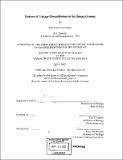Patterns of linkage disequilibrium in the human genome
Author(s)
Liu-Cordero, Shau Neen, 1970-
DownloadFull printable version (17.22Mb)
Other Contributors
Massachusetts Institute of Technology. Department of Biology.
Advisor
Eric S. Lander.
Terms of use
Metadata
Show full item recordAbstract
Although enormous progress has occurred in the field of human genetics, the cloning of complex trait mutations remains a challenging and unresolved process. This continuing difficulty is responsible for an ever-increasing awareness of the phenomenon of linkage disequilibrium (LD). The principle behind LD is relatively simple. Over the lifetime of a population, the genetic markers that are adjacent to an ancestral mutation will recombine less often than more distant markers. Therefore, the ancestral alleles of the markers closest to the mutation should be most frequent in a collection of disease chromosomes. The allelic association should decrease as the distance from the ancestral disease mutation increases. This thesis is a collection of ideas and experiments aimed at dissecting the behavior of LD in the human genome. Specific studies examine LD in a variety of populations including isolated founder populations, as well as globally diverse population samples. A large number of regions throughout the genome are investigated using both pairwise comparisons of markers, as well as multimarker haplotypes. The X chromosome is more closely scrutinized because of its unique population history, as well as the advantages afforded to haplotyping due to hemizygosity of the X chromosome in males. Major conclusions include the observation that LD between pairs of markers is highly variable even at extremely close distances and multimarker haplotypes better serve to resolve the underlying haplotype structure of the genome. (cont.) The genome appears to be structured as blocks of limited haplotype diversity that do not exhibit much internal recombination but which are separated by segments that show little or no LD. The lack of LD between haplotype blocks appears to be due to clustering of recombination events into specific hotspots. The size of the blocks and haplotype diversity varies slightly by population. In addition, the identity of the haplotypes varies between populations. The existence of 3-4 major haplotypes for specific regions in a diverse human population sample is a surprising finding that was originally believed to have only existed in very special isolated and young populations.
Description
Thesis (Ph.D.)--Massachusetts Institute of Technology, Dept. of Biology, 2002. Includes bibliographical references.
Date issued
2002Department
Massachusetts Institute of Technology. Department of BiologyPublisher
Massachusetts Institute of Technology
Keywords
Biology.